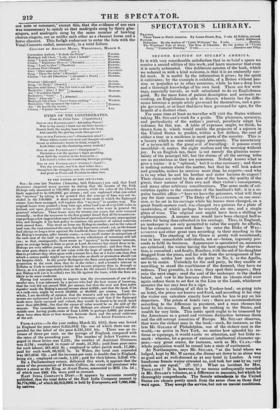TO THE EDITOR OF THE SPECTATOR.
your last 'Number •( Saturday, 16th February) you said, that Lord ALTHORP surprised -many persons by stating • that the income of the Irish Bishops only amounted to 130,0001. per annum, while the value of the Church lands appeared to be 600,000/. per annum ; and you explained what you called the "mystery" by taking it for granted that the "average of fines was not included in the 130,0001. A short ort account of the mode n which the Episcopal estates have been managed; will explain this "mystery" in another way. The original leases were granted a long time ago, when land was of very little value in Ireland, and upon favourable terms to the tenants, who were in general the grantors' relations. These leases were for twenty-one .years; but were renewed annually ; so that the successor to the first grantor found that all his tenants (except perhaps a few improvident ones) had terms of upwards of twenty years against him, and thought it his best policy to continue the practice of annual renewals with aimual fines. This went on from one Bishop to another, and as the value of land rose, the rent remained the same, but the fines were raised ; yet, as the tenant had always so long a term against the landlord, those flues could only represent the Bishop's reversion after twenty years,—a very small matterin comparison of the rack-rent of the land in possession, as any calculators of reversions will tell you; so that, consequently, there seems no "mystery" in the tenants' interests, upon an average being at least as great as Lord ALTHOar has stated them to be. Bishops are very seldom young men when first consecrated ; and then they, for the most part, obtain a see of low value with the hope of speedy translation ; so that in prudence they often agree with a tenant for a fine at a lower rate than that which a notary public might say was the value as death or promotion should cut the bargain short. In the poorer Bishoprics the fines consequently bear a larger proportion to the rents than they du in the richer ; and a tenant's interest in Killaloe or Cork is considered a better and securer property than in Armagh or Derry, as it is most improbable that in these, for the reasons I have above stated, any Bishop will (as it is called) run his life against the lease, while the fines are likely to be more moderate: Haying had occasion lately to inquire into the circumstances of one of the smaller sees, I was informed, by a person who had the best means of knowing, that the rent did not exceed 700/. per annum, but that the rent and fines taken together made the Bishop's annual Income about 4,0001., and that the land, if let at a rack-rent, might be worth 30,000/. or 40,0001. per annum. Upon the whole, I am decidedly of opinion that the tenant's and not the landlord's interests are underrated in Lord ALTHORP'S statement ; and that if the Episcopal lands were fairly surveyed and valued, they would be found to be worth 'much more than 600,0001., but that the excess of value would be on the side Of the tenants. The immediate tenants of the Bishops are almost (I might -say all) iniddle.men having profit-rents of from 1,0001. to perhaps 3,000/. per annum: these have often three or four tenants between thein and the actual cultivator of the soil. Yours, &c. AN IRISH PROTESTANT.
POOR-RATES.—In the year ending March 25, 1832, there was levied in England for poor-rates 8,255,315/. 12s. out of which there was expended for the relief of the poor 6,731,131/. 10s. There was an increase of three per cent, on the average of England, compared with the rates of the preceding year. The number of Select Vestries engaged in these levies was 2,234; the number of Assistant Overseers was 3,134; employed in repair of roads' 51,705; paid from poor-rates for such labour, 261,465/. Ss.; employed in other parish work, 17,390; paid for such work, 88,2571. 7s. In Wales, the total sum expended was 367,6041. 12s. ; and the increase per cent, is double that in England, being six • employed on roads, 1,131 ; paid for their labour, 3,354/. 47s.. By a Parliamentary return, delivered this week, it appears that the costs of the prosecution of Dennis Collins, the crazy old pensioner who threw a stone at the King, at Ascot Races, amounted to 3971. lls. Id.; of which sum 2461. 19s. were paid to counsel. EAST INDIA COMPANY'S DEBT.—It appears by accounts recently published, that the total debts of the East India Company amount to 30,774,09214 of which 22,913,990/. is held by Europeans, arid 1,860,10W. by natives.


















 Previous page
Previous page